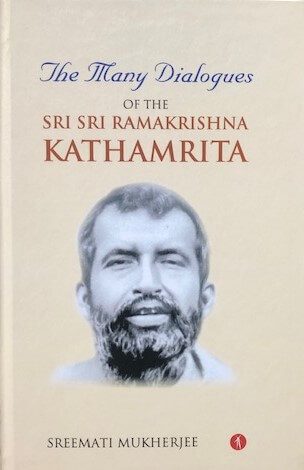Reading Time: 7 minutes
Here is Gopal’s multi-layered review of Sreemati Mukherjee’s book, The Many Dialogues of the Sri Sri Ramakrishna Kathamrita. An exclusive for Different Truths.

Book: The Many Dialogues of the Sri Sri Ramakrishna Kathamrita
Author: Sreemati Mukherjee
Publisher: Hawakal Publishers
Sreemati Mukherjee in her engaging book titled ‘The Many Dialogues of the Sri Sri Ramakrishna Kathamrita’ excavates the ideas of faith and joyous freedom in a series of dialogues between leading intellectuals of Kolkata, like Girish Ghosh, Narendranath Dutta, Keshab Chandra Sen, Dr. Mahendralal Sarkar, Mahendranath Gupta, etc., and Sri Sri Ramakrishna.
In the multi-layered, all-encompassing and polyphonous text of ‘Kathamrita’, the chronicler M (Mahendranath Gupta) is largely silent.
In the multi-layered, all-encompassing and polyphonous text of ‘Kathamrita’, the chronicler M (Mahendranath Gupta) is largely silent. He shares his intense love and devotion with Sri Sri Ramakrishna. A warmth suffuses the book. And we begin to see everyone in a new light.
In her Introductory narrative, the author has mentioned, “I would like to use the word ‘dialogic’ to describe the teeming world of the Kathamrita, the term being derived from Mikhail Bakhtin’s The Dialogic Imagination, where Bakhtin uses the term to explain the multifarious and polymorphic nature of the novel.”
Dialogic Reading
Here the dialogic reading involves exploration of the text at a deeper level, including defining denotation, analysing various components, and deciphering the mutually challenging excellences of many languages and meanings. The language of Vedas, Upanishads, shastras, myths of Puranas, and others offer succour to the grieving. A series of nuggets of wisdom and comfort for times of trouble.
The presence of many languages of Sri Sri Ramakrishna Kathamrita that the author unearths are rich and moving.
The presence of many languages of Sri Sri Ramakrishna Kathamrita that the author unearths are rich and moving. She observes, “there are many languages which dialogise with each other.”
Besides the introductory deliberations on the Many Dialogues of the Sri Sri Ramakrishna Kathamrita, there are five major chapters in the book. These deal with Symphonies of dance, Song and Epistemology in Sri Sri Ramakrishna Kathamrita. Sri Chaitanya as Affect and Epistemology in Sri Sri Ramakrishna Kathamrita. Sri Ramakrishna as Poet and Philosopher, Redeemer and Redeemed. Girish Chandra Ghosh and Sri Ramakrishna. And Science in Dialogue with Bhava or Ecstasy Dr. Mahendralal Sarkar and Sri Ramakrishna. Bibliography, Terms Frequently used and Mythological Characters, Characters who appear in the book and Acknowledgements are also annexed at the end.
A Strong Narrative
The book has a strong narrative. Wafting through the text and the narrative itself, it unspools largely as a discursive meditation comprising the philosophical exchanges with the various characters. What is laudable is that the book is detailed and comprehensive in its research.
It deserves a serious look.
It deserves a serious look. Because along with numerous accomplishments, it’s much more pivotal than many of us currently believe. In sum, it’s all introspective. And each chapter is their own universe where, as if, fiction and reality intertwine. In many dialogues, different voices and perspectives are allowed to coexist. Thus, it undercuts any intolerance about spirituality and religion.
Sri Ramakrishna says, ‘I have seen that there are many paths and many beliefs. I dislike it that people fight amongst themselves. This much I have understood – He is the whole and I am the part- He is the Master, and I am the servant. And yet again, there are times when I think. He is me and I, Him!’ (M 594)
Colonial Context
The author’s observations are engaging and insightful. She delves deeper more meaningfully into the life of Sri Ramakrishna. And she believes his intense spiritual qualities cannot be limited by the colonial context, which some of the historians lead us to accept as true.
‘To locate him entirely within a colonial fabric is to drastically limit the range of his personality which certainly owed a great deal to the rigorous and arduousness of profound spiritual endeavour and was possibly also the reason for his personal magnetism.’
Her finely drawn narrative gives the book another meaning.
Her finely drawn narrative gives the book another meaning. One that hints at the magical power and charm of personality of Sri Ramakrishna. The wide range of his spiritual sadhana. And his songs revolve around mortality and redemption, unveiling an elevating existence. The choice to surrender to higher guidance, to listen deeply to one’s inner voice and soul’s beckoning, is a higher level of conscious engagement. Sri Ramakrishna tells Keshab Chandra Sen about God (highest rasa)
‘If one is sincere one can gain God even in worldly life. ‘Me and mine’ is ignorance and ‘you and yours’ is knowledge (M 660). I tell you to renounce in your minds. If you can detach your mind from worldly matters, then you may gain God (M 660)’
Contemplative Practice
Cultivation of contemplative practice is important. So is the need for faith. Sri Ramakrishna tells Kali, ‘Mother, faith is so necessary. I don’t care for analysis.’ The more you intentionally turn inward, the more available the sacred becomes. When you sit in silence and turn your gaze toward the Holy Mystery you once called God, it helps you to find rest in the arms of the formless Beloved. And as envisaged by Tagore, it increases your chance of being stunned by beauty and love.
Sri Ramakrishna is insistent that universal love makes the world go round. And he breaks into song in a state that M describes ‘drunk with love’ (M 53):
Ke jane kali Kemon, shada darashane na pai darshan
This song was written by Ramprasad, a renowned Shakto…
This song was written by Ramprasad, a renowned Shakto, (worshipper of Goddess Kali). Other composers whose song were also sung in Kathamrita were Kamalakanta Chakrabarty and Kamalakanta Bhattacharya. The author has further added that in Kathamrita, one sees Sri Ramakrishna’s ecstatic love for Kali, Krishna, Chaitanya and even Radha or Sreemati. The author has noted,
‘The recurrence of the songs gives the narrative an internal unity and harmony that serve to underscore some of the central philosophical concerns running through the Kathamrita and brings musical and oral resonance that is symphonic.’
Vision of Life
Poetry is a refined vessel known to mankind, which can contain and transmit a vision of life – pure love and bliss. Dreams and visions are as important as sound and senses. They become an important part of Sri Ramakrishna’s ontology. He said, “…is dream a small thing?” And he was fond of uttering the names of gods and goddesses. These resonate through the Kathamrita creating a preeminent level of reverberation besides songs.
It is striking in both its insistence and its specificity.
In this hallowed collection of spiritual dialogues in Kathamrita, the refrain of ‘Put the mind in your heart’ appears all along. It is striking in both its insistence and its specificity. Sri Ramakrishna’s artistic and imagistic teachings emerge, which features the love in a far more spacious and luminous role. He explains to Bankim Chandra, that Krishna and Radha are one and indivisible.
‘Krishna is bent out of love for Radha…Krishna and Radha, the male principle and the female principle are one and invisible- just like fire and its burning capacity…Sri Krishna remains rapt in Radha and She in Him…’ (M 1119).
A Deeper Reality
The primary function of Sri Ramakrishna’s Sadhana is to look beyond the obvious, the enclosed surface of things. He sees into a deeper reality, emerging from some unknown profundity. These play lightly upon the surface of this life without being caught there: a world where meaning, insight, and clarity come together in a whole different way.
The confrontation with the impermanence of all things is perhaps the widest gate to liberation from suffering.
The confrontation with the impermanence of all things is perhaps the widest gate to liberation from suffering. Facing death or dealing with death, our sight becomes clear. Sri Ramakrishna’s answer on the idea of God as having form or formless:
If after the knowledge that Brahman alone is real and the world unreal, one has samadhi, then one bids goodbye to the world of name and form for ever. Then one does not think of God as a person anymore. At that point Brahman is Nirguna. He can only be realised through a sense of him. He cannot be attained through the mind and intellect. (M 929)
Echoing the central desire for spirituality, Kathamrita, has a free form structure. It flows from one immersive conversation to another. References to Western Philosophy also come in the exchanges with Narendranath Dutta and Girish Ghosh. As pointed out by the author, Sri Ramakrishna’s deep love for Girish Ghosh, the father of Bengali Theatre, is well-known. On his striking changes his life, Girish Ghosh tells, Sri Ramakrishna:
Sir, with your grace everything may be possible. Look what I was and what I have become (M 738).
Sri Ramakrishna replies:
You had the preparedness (samskara), that is why it is happening. Nothing happens till the right time arrives.’ (M 738).
A Wide Range of Topics
The ‘dialogic’ presence of reason is evident in the interaction between Dr Mahendralal Sarkar and Sri Ramakrishna.
The ‘dialogic’ presence of reason is evident in the interaction between Dr Mahendralal Sarkar and Sri Ramakrishna. These cover a wide range of topics of science and research, power and reach of music, meditation, ecstasy, and many others. Sri Ramakrishna trusts that faith is not a leaping into the dark (as so often misconstrued) but a subtle seeing in the dark. It’s a kind of spiritual vision that allows one to see God with inner certainty.
‘God Visited me when I was a child. What did I see on the field? I lost consciousness. Since that day I have always seen someone inside me. Sometimes during puja, I would put the flower on my head instead that of the deity. A young boy who used to stay with me used to say, there is such a light on your face, that I am scared to go near to you.’ (M 964).
The author has rightly mentioned, “Sri Ramakrishna posits that after God-realisation the jnani must choose to stay with bhakti, compassion and detachment, which would accomplish two ends.”
Scholarly Interpretation
Sreemati Mukherjee’s elegantly cerebral meditation and analysis of the various dialogues embedded in Kathamrita serves as a scholarly interpretation. And serves a documentarian function as well. Intense, detailed, and fast-paced, the book is a delightful and rewarding read.
This engaging book offers a dialogic reading of Sri Ramakrishna’s spiritual and aesthetic exchanges.
The cover page is impressive. This engaging book offers a dialogic reading of Sri Ramakrishna’s spiritual and aesthetic exchanges. It plucks at the very borders and burdens of the notion of a self. And is worthy reading. Hawakal Publishers deserves special praise for the publication of this important book.
Visuals sourced by the reviewer
















Gopal-da, you’ve done a magnificent job! Apart from the thoroughgoing nature of the critique, your sincerity in delving deeply into the text has truly moved me. I like the phrase where you say that ‘faith’ is not a leap into the ‘darkness’ but a subtle exploration of the dark for light. You’re also one of the first ones to publish a critique. Once again, thank you!